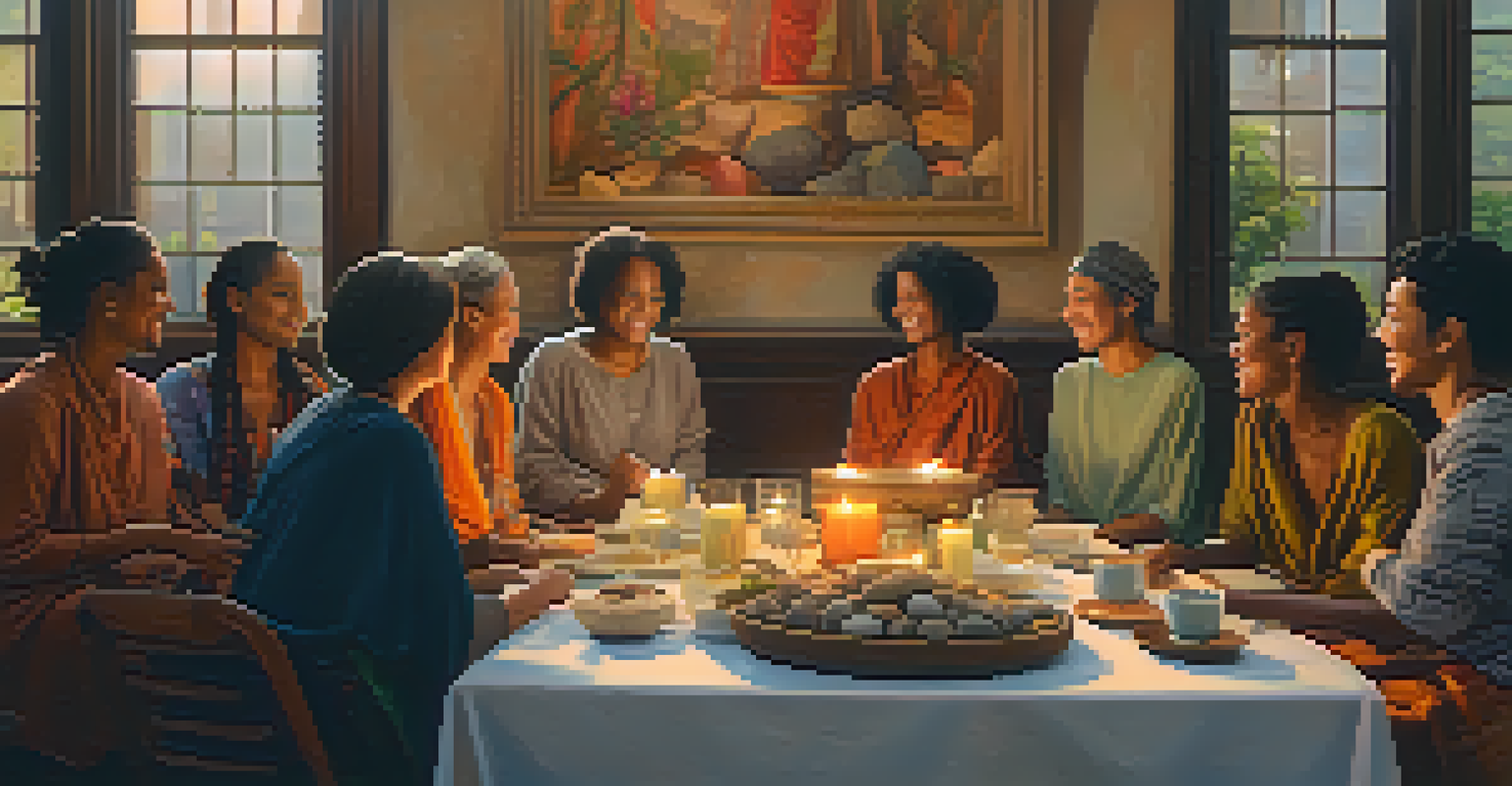Entheogen Use in Community: A Path to Collective Healing

Understanding Entheogens and Their Role in Healing
Entheogens, often referred to as psychoactive substances, have been used for centuries in various cultures for spiritual and healing purposes. These substances, such as psilocybin mushrooms and ayahuasca, can induce profound experiences that foster personal insight and connection with others. At their core, entheogens are seen as tools to access deeper states of consciousness, enabling individuals to explore their inner landscapes.
The use of entheogens is a window into the soul, allowing us to connect deeply with ourselves and each other.
In community settings, the use of entheogens can catalyze collective healing by creating shared experiences that deepen bonds among participants. When people come together under the influence of these substances, they often experience heightened empathy and understanding, which can lead to meaningful conversations and transformations. This process can help break down barriers and promote a sense of unity.
Moreover, the communal aspect of entheogen use can enhance the healing process, as participants support one another through their journeys. This shared vulnerability fosters trust and encourages open dialogue about personal challenges. In this way, entheogens can serve as a bridge, connecting individuals to each other and to a larger sense of purpose.
Historical Context of Entheogens in Community Rituals
The use of entheogens is deeply rooted in many cultures, often integrated into rituals and ceremonies designed to promote healing and connection. Indigenous groups, for instance, have utilized substances like peyote and ayahuasca in communal settings for generations, viewing these experiences as sacred. These rituals often involve music, dance, and guided facilitation to create a safe environment for participants.

Throughout history, these practices have allowed communities to process grief, trauma, and collective memories together. In many cases, they serve as a means of collective storytelling, where shared experiences help reinforce social bonds and cultural identity. This historical context highlights the importance of community support in the healing journey, as participants navigate their experiences in a group setting.
Entheogens Foster Community Healing
Entheogens create shared experiences that enhance empathy and connection, promoting collective healing among participants.
As society continues to explore the therapeutic potential of entheogens, there is a growing recognition of the value of these ancient practices. Modern initiatives are beginning to incorporate traditional wisdom into contemporary healing modalities, blending ancient rituals with current therapeutic approaches. This fusion can lead to more holistic ways of understanding and addressing communal issues.
The Science Behind Entheogens and Community Healing
Recent research indicates that entheogens can have significant psychological benefits, promoting healing at both individual and community levels. Studies have shown that substances like psilocybin can lead to reductions in anxiety, depression, and PTSD symptoms, making them valuable tools in therapeutic settings. This scientific backing is crucial for understanding how these substances can be effectively integrated into community healing practices.
When we share our journeys, we not only heal ourselves but also weave a tapestry of connection that binds us together.
Additionally, entheogens are known to foster neuroplasticity, the brain's ability to reorganize itself by forming new neural connections. This effect can enhance social bonding and emotional resilience, helping individuals feel more connected to each other and their communities. The potential for these substances to facilitate positive change is a compelling reason for communities to explore their use thoughtfully.
Moreover, the communal experience of using entheogens can amplify these healing benefits. When individuals engage in shared rituals, they not only support one another but also create a collective consciousness that enhances the therapeutic effects. This synergy between individual and communal healing is a powerful aspect of how entheogens can transform communities.
Creating Safe Spaces for Entheogen Use
To harness the healing potential of entheogens effectively, creating safe and supportive environments is essential. This involves not only physical safety but also emotional and psychological support during experiences. Communities that prioritize safety can foster trust and encourage participants to explore their inner worlds without fear of judgment.
Facilitators play a crucial role in this process, guiding participants through their journeys while ensuring that everyone feels secure. This guidance can include pre-journey preparation, assistance during the experience, and post-journey integration sessions, where individuals can process and discuss their experiences. Such comprehensive support can greatly enhance the healing potential of entheogen use.
Historical Roots in Ritual Practices
Many cultures have long integrated entheogens into rituals, using them to process grief and reinforce social bonds.
Additionally, establishing clear guidelines and boundaries is vital for maintaining a respectful and nurturing atmosphere. This includes informed consent, open communication, and respect for individual experiences. By prioritizing safety and support, communities can create spaces where collective healing can flourish.
Real-Life Examples of Community Healing with Entheogens
Across the globe, numerous communities have successfully integrated entheogens into their healing practices, with inspiring results. For instance, in the Amazon rainforest, indigenous tribes have long used ayahuasca in ceremonial contexts, fostering communal healing and spiritual growth. These ceremonies often involve sharing personal stories and insights, reinforcing the bonds between participants.
In urban settings, grassroots organizations have begun to adopt similar practices, hosting group sessions where individuals can explore their experiences with substances like psilocybin. These gatherings often emphasize community dialogue and support, creating a nurturing environment for healing. Participants frequently report profound insights and connections, leading to lasting changes in their relationships and mental health.
These examples illustrate the transformative potential of communal entheogen use, offering a glimpse into how communities can come together to heal. By sharing their journeys, individuals not only support each other but also contribute to a larger narrative of resilience and collective growth. These stories serve as powerful reminders of the healing that can occur when we unite in pursuit of understanding and connection.
Challenges and Considerations in Entheogen Use
While the benefits of entheogen use in community healing are promising, there are also important challenges and considerations to keep in mind. Legal restrictions in many regions pose significant barriers to accessing these substances and can complicate community efforts to implement healing practices. Navigating these legalities requires careful planning and advocacy for responsible use.
Furthermore, not everyone may have the same level of comfort or readiness to engage with entheogens. It’s crucial for communities to respect individual boundaries and ensure that participation is voluntary. This respect for personal choice can help prevent potential harm and foster a more inclusive environment.
Challenges in Entheogen Implementation
Legal restrictions and individual comfort levels pose significant challenges to the responsible use of entheogens in community healing.
Lastly, as interest in entheogens grows, there is the risk of commercialization and commodification, which can detract from the authentic connections these practices aim to foster. Communities must remain vigilant in prioritizing ethical practices and the sacred nature of these substances, ensuring that their use is rooted in respect and understanding rather than profit.
The Future of Entheogen Use in Collective Healing
Looking ahead, the potential for entheogens in community healing is vast, with increasing interest from both researchers and practitioners. As more studies emerge highlighting their benefits, there is hope for a broader acceptance and integration of these practices into mainstream mental health care. This shift could pave the way for new therapeutic modalities that prioritize both individual and collective healing.
Moreover, as communities continue to explore the use of entheogens, there is an opportunity to create more inclusive spaces that honor diverse cultural practices and experiences. By learning from indigenous traditions and modern therapeutic approaches, communities can develop holistic models of healing that resonate with a wide range of individuals.

Ultimately, the future of entheogen use in collective healing lies in the hands of those who are willing to engage thoughtfully and responsibly. By fostering open dialogue, prioritizing safety, and embracing the wisdom of past practices, communities can harness the transformative power of entheogens to heal and connect on a deeper level.